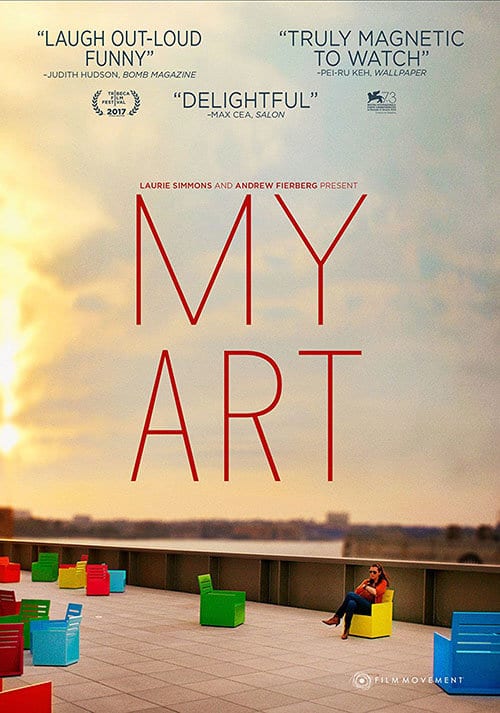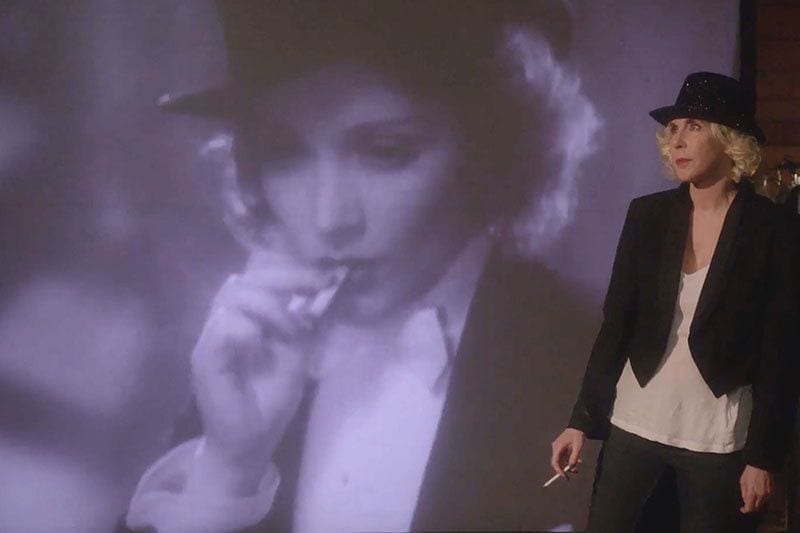
The artist Laurie Simmons’ first foray into dramatic filmmaking sees her treading some new ground as well as familiar waters. If you are not familiar with her expansive artwork in
photography and fashion, you may have caught her in her daughter Lena Dunham’s directorial debut, Tiny Furniture, the little film that made big waves at South by Southwest and launched Dunham’s career. The film was spiritually similar to HBO’s Girls, but with Simmons playing the mother to Dunham’s character. Simmons played an artist similar to herself in that one too, and it made a lot of sense to see Dunham coming from a family of artists, striking out on her own, and getting a little lost.
What Simmons has done in
My Art is taken a similar approach to storytelling as Dunham. In addition to writing and directing My Art, she stars as the film’s protagonist, Ellie, a New York visual artist who spends the summer in rural New York house-sitting for a friend in a beautiful mansion. Her investment in this time away from the city is reconnecting with her craft and creating a space to make new art pieces. It isn’t clear how famous Ellie is. You get the sense that she’s a working artist and all her friends are filmmakers, photographers, or actors. But it isn’t stated plainly if Ellie is as famous as Simmons, or if she is doing just well enough to afford to spend the summer creating art while living in the boonies.
For the duration of the movie we watch Ellie orient herself with the space, a sprawling country home with a rustic barn she makes into an art space, and a garden tended by local out-of-work actors. There’s also a wobbly dog you grow attached to. The art Ellie begins to create is recreations of classic Hollywood films, experimenting with costumes, sets and lighting, to re-shoot their most famous scenes, but with herself as the star. She starts with Marlene Dietrich’s famous scene in
Morocco, where Dietrich dared to wear a man’s suit and top hat. Ellie dons a perfect Dietrich-like wig and learns the blocking and movements, getting herself on film with the movie camera she borrowed from her friend, Mickey.
As she makes connections with the locals she gradually fits them into her projects as well. Now that she has Frank (Robert Clohessy) and Tom (Josh Safdie), the gardeners/actors, she can play out scenes with more characters, like Jules Et Jim, A Streetcar Named Desire, On the Waterfront, and Some Like It Hot. “That’s gotta be the best ending in film history,” she says of the latter, and seeing their version of it, you may just agree with her.
The work they’re doing together is reminiscent of young, excited kids doing a shot-by-shot
recreation of Indiana Jones. But inside the world of My Art, Ellie’s art is different. It’s not about being Marilyn Monroe and Clark Gable, she explains to Frank. “It’s exactly about the impossibility of being them. We could never be them.” She has found an artist’s statement for her work. A Clockwork Orange, Rocky (or is it Raging Bull?), we watch her continue having fun with her new friends, and at one point her old friends from the city show up to throw her a surprise party, and she gets to watch her new friends co-mingle with her old friends, and the joy and dread that brings.
Like many independent, low-budget films, particularly in the
Mumblecore scene, as well as Tiny Furniture or an episode of Girls, there isn’t a compelling, suspenseful plot driving the events of the movie forward. It’s just a story of one woman’s summer where she made some friends and they all made charming art together. And you get to see a woman over 60 in a position of power directing how she wants her art to go, in a position of turning down sex she doesn’t want to have, accepting sex she does want to have, and none of it derails her summer. It’s just a depiction of freedom and creativity, with the creation of the art driving the film forward more than any melodrama between human relationships. While it doesn’t seem to be a straight autobiography, it feels close to Simmon’s own artistic experience (staging dolls, miniatures, models to recreate scenes both artificial and domestic), in the same way that the aforementioned films seem to capture those artists’ experiences, or Seinfeld is about a comedian modeled after Jerry Seinfeld.
For me, the best storytelling is good character development, and if you nail that, you can get away with having very little conflict resolution or plot, or even little character arcs or changes. With Ellie, Simmons has fleshed out a truly interesting artist that feels closer to what a working artist really is, versus a tortured eccentric genius. Ellie has graduated past the bullshit of letting people dominate her time or energy unless she so chooses. We see her abruptly ending conversations with an “OK, bye!” and suddenly walking away, leaving the other person to finish their thought quickly and wave. She doesn’t lie to get out of a conversation, she just leaves when she’s done with it.
She also spares no bones when someone does something she doesn’t like, such as when Mickey tries to give her an artist prompt, or when Frank slinks into the house unannounced. She tells them exactly what she thinks of their actions in that moment, and doesn’t minimize her own feelings about it. In many ways, she is a model for how we should all be. Any artist or writer watching this film will feel a pang of envy watching Ellie build out her artists’ space with all this time and energy at her disposal. If only we all had such time, resources, and energy stores.
The look and feel of
My Art is sunny and green, with warm visuals that have a clear artist’s eye for photography. The film was not designed to be a big budget blockbuster but it is still visually stimulating. Some reviewers have rated it fairly low, and it didn’t return a lot of money at the box office. However, if you like movies where people experience joy and fulfillment in their work, and building a community, and don’t care about convoluted plot, then you might be the audience for this movie. Also, if you love Parker Posey cameos. It would be worse if Simmons had tried to cook in some half-baked plot rather than just tell the story of a productive, engaging summer.

